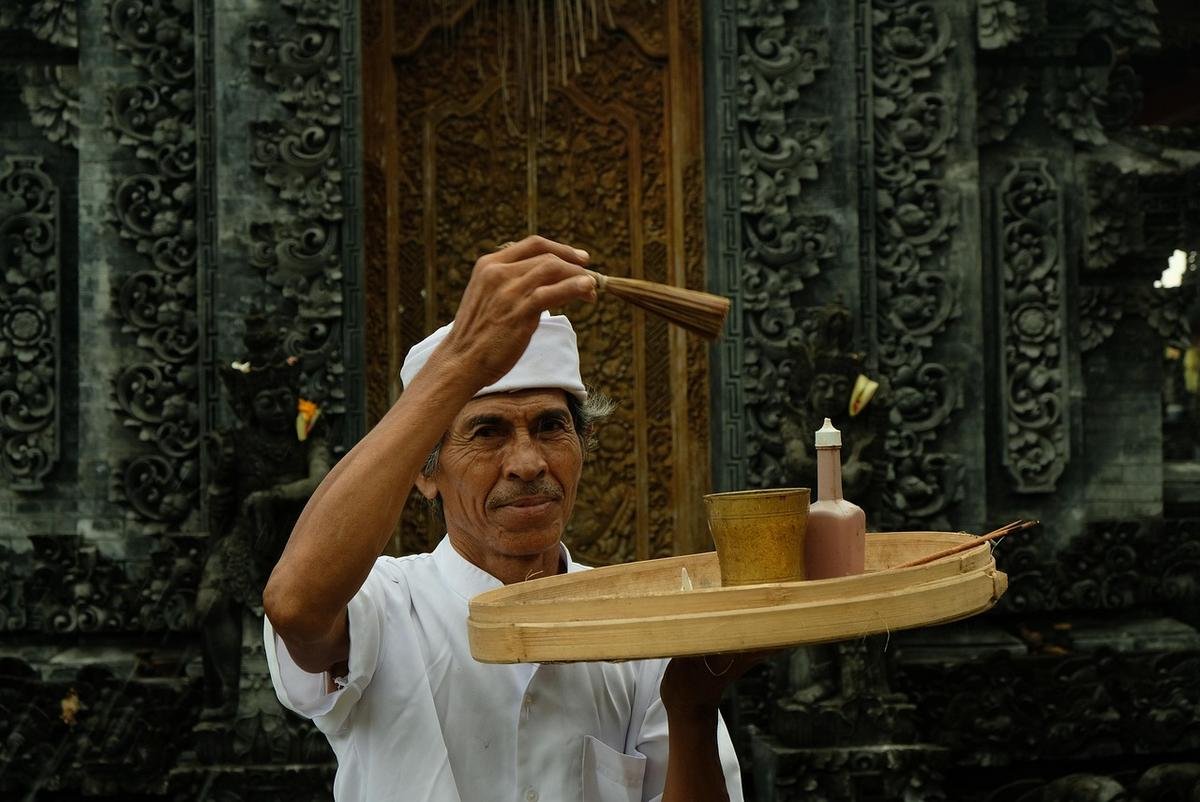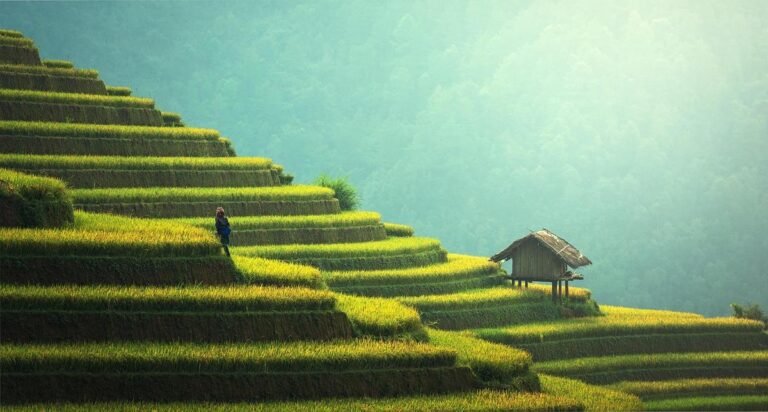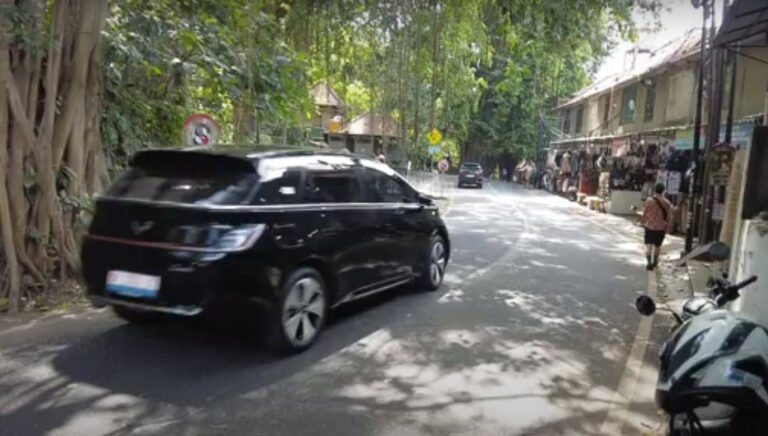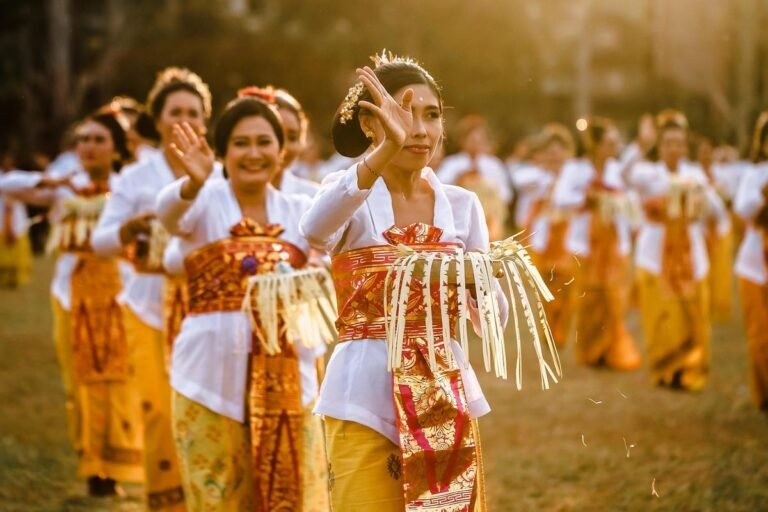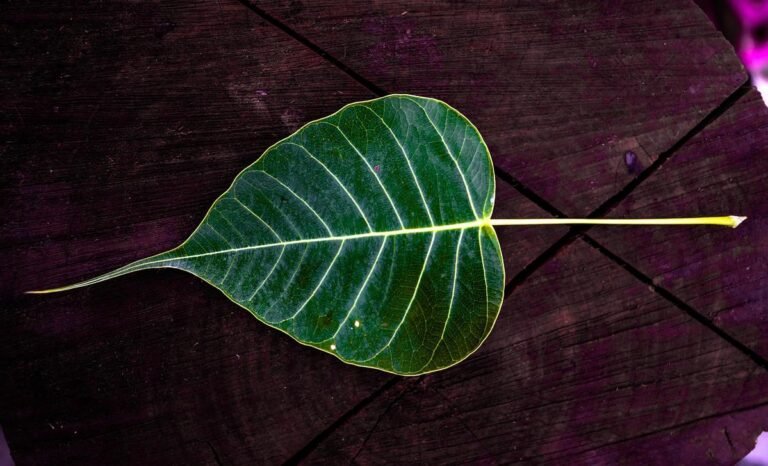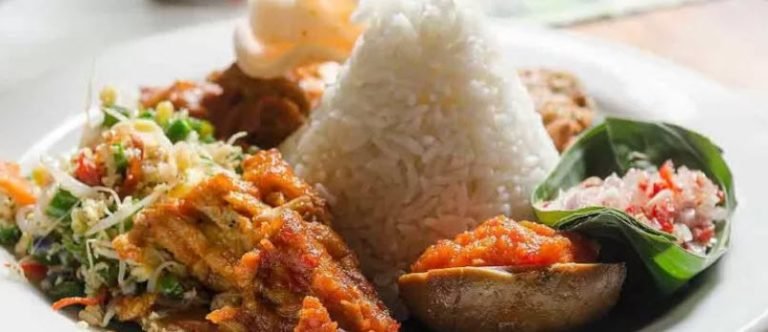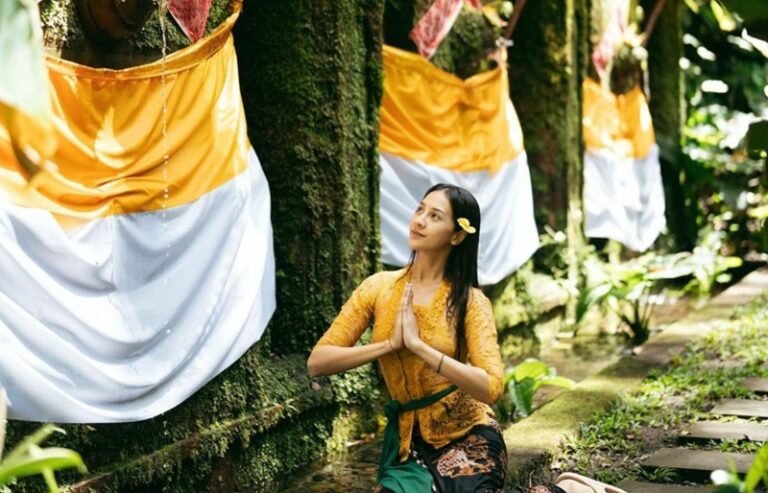Merajan Agung Kawitan Temple Offers Tranquility and Upholds Bali’s Arya Kubon Tubuh Heritage
Merajan Agung Kawitan Sira Arya Kuthawaringin Temple sits at the center of a district rich in Balinese spiritual heritage. The shrine perches on a rise above paddy fields and coconut palms. Narrow paths wind under banana leaves toward the entrance. Stone staircases lead through gates carved with guardian figures into an inner courtyard. Frangipani trees line the terraces, their fallen blossoms covering the brick floor. Descendants of Arya Kubon Tubuh come here to renew ties with ancestors whose guidance shaped local life. A hush often falls over the grounds, broken only by distant chants and the wind through frangipani trees. Morning breeze carries the aroma of incense and frangipani, mingling with the earthy scent of rain-washed stone. Birds flit from roof to roof as sunlight picks out gilded carvings along the rooftop edges.
As worshippers pass under a candi bentar gateway etched with guardian figures, they reach a paduraksa entrance flanked by naga carvings. Within, open pavilions and multi-tiered meru towers stand in precise alignment along paved courtyards. Carved reliefs depict ancestral legends and daily life in rice fields. Small shrines rest on sculpted pedestals where banana leaf offerings await. Water-filled ponds between shrines reflect carved doorways in their still surfaces. The ordered layout embodies a belief that mortal affairs and the spiritual plane exist in a state of careful balance.
Chronicles preserved as palm-leaf manuscripts carry the Babad Sira Arya Kuthawaringin-Kubontubuh narrative. They date the temple’s origins to the rule of the Dalem Ketut Semara Kepakisan line. Those texts record how Kyayi Gusti Agung Bandesa Gelgel consulted high priests and spring waters before laying the first stones. They describe his efforts to extend royal influence along Bali’s east coast and outline rules he set for priests, potters, and woodcarvers. His model of temple governance anchored Merajan Kawitan as the family’s center of authority and worship.
In Saka year 1305 (1383 AD), Ida I Dewa Ketut Ngulesir ascended Bali’s throne as Dalem Sri Smara Kepakisan, establishing his palace in Gelgel. Kyayi Gusti Agung Bandesa Gelgel then passed the temple to the new monarch for use as a royal shrine. In return, he built a new palace amid coconut groves at Abian Kawan. His title became Kyayi Klapodhyana, or I Gusti Kubon Tubuh, a name his descendants inherited alongside the shrine’s care.
The shrine holds layered duties for Pratisentana Sira Arya Kubon Tubuh-Kuthawaringin:
- Pura Pesimpenan safeguards palm-leaf manuscripts of the Ajipurana Anugerah Ida Dalem Ketur Semara Kepakisan, Babad chronicles, and prasasti tablets. Elders say the vault once held ten legendary spears and ceremonial umbrellas that symbolized royal authority.
- Pura Kawitan serves as the seat of Ida Bethara Kawitan, where daily puja unfolds in the bale tegeh hallowed by morning lamps.
- Pura Merajan Agung brings together the extended Arya Kuthawaringin lineage for rites and communal feasts, with family portraits and felt banners from past eras displayed along its walls.
The complex embodies manu wangsa, the lineage deemed blessed by Ida Hyang Widhi. A coconut sprout found at Gedong Bethara Lingsir became a sign of that favor. Each festival, priests perform purification rites for its roots and wrap the base in woven palm fronds. The plant remains a living emblem of the family’s elevated standing within Bali’s traditional order.
Temple grounds follow the Tri Mandala concept, dividing the site into three concentric zones. Nista Mandala at the entrance houses stalls for incense and offerings. In Madya Mandala, bale kulkul towers and open pavilions host preparations for prayer. Beyond, Utama Mandala encloses the primary sanctuaries, including Gedong Bethara Lingsir. Passing each gate represents a progression toward ritual focus and ceremonial purity.
Within Utama Mandala stand three key buildings:
- Gedong Bethara Lingsir holds the main altar to Ida Bethara Kawitan, featuring gilded trim, relief panels, and lotus-painted doors. Brass bowls sit atop stone pedestals under a high-peaked roof.
- Gedong Tarib lies to the north, its teak columns carved with floral motifs and lion figures. Priests recite prayers here to invoke protective spirits.
- Tugu Agung rises above the inner courtyard as a multi-tiered carved pillar topped with finials. Its stone base is encircled by small shrines honoring lesser deities tied to harvest and rain, linking community needs to divine care.
One notable chapter recounts Kyayi Klapodhyana’s proposed marriage to I Gusti Ayu Adi, daughter of Kyayi Nyuh Aya. Disputes over ceremonial details threatened to derail the union. Dalem Ketut Semara Kepakisan mediated talks in the Madya Mandala courtyard, negotiating terms for seating order and gift exchanges. The resolution restored peace, bolstered Kyayi Klapodhyana’s status, and showed how wisdom can heal family discord.
The temple hosts ceremonies that honor Ida Bethara Kawitan and maintain harmony among people, nature, and the unseen world. Priests arrange offerings of fresh blossoms, incense sticks, cloth wraps, and coconut water on stone shrines. Devotees gather under bale pavilions to recite ancestral chants before dawn light. After formal rituals, families share rice cakes and fruit laid on banana leaves. Each ceremony renews communal bonds and links participants with their forebears.
Pratisentana Sira Arya Kubon Tubuh members continue to care for the temple, cleaning moss from brick walls, repainting carved railings, and preparing daily offerings. Each month, elders hold sessions where youths learn traditional chants and dance forms once performed at royal courts. Conservation teams monitor stone reliefs for damage, restoring weathered motifs with lime mortar. At dusk, oil lamps glow in every niche and the scent of frangipani drifts through open gates. During major rites, lanterns hung on bamboo poles light the compound as masked dancers enact ancestral stories along the pathways. Visitors who pause at the entrance may watch processions winding toward Gedong Tarib, a reminder of enduring duty and the deep bond between lineage, land, and the sacred.

